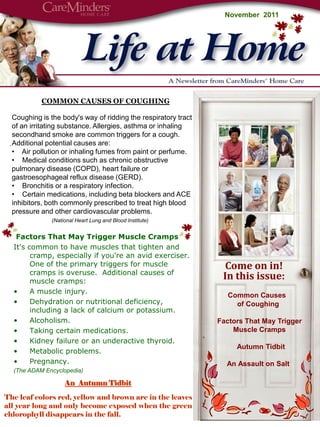
November 2011 Newsletter
- 1. November 2011 COMMON CAUSES OF COUGHING Coughing is the body's way of ridding the respiratory tract of an irritating substance. Allergies, asthma or inhaling secondhand smoke are common triggers for a cough. . Additional potential causes are: • Air pollution or inhaling fumes from paint or perfume. • Medical conditions such as chronic obstructive pulmonary disease (COPD), heart failure or gastroesophageal reflux disease (GERD). • Bronchitis or a respiratory infection. • Certain medications, including beta blockers and ACE inhibitors, both commonly prescribed to treat high blood pressure and other cardiovascular problems. (National Heart Lung and Blood Institute) Factors That May Trigger Muscle Cramps It's common to have muscles that tighten and cramp, especially if you're an avid exerciser. One of the primary triggers for muscle Come on in! cramps is overuse. Additional causes of muscle cramps: In this issue: • A muscle injury. Common Causes • Dehydration or nutritional deficiency, of Coughing including a lack of calcium or potassium. • Alcoholism. Factors That May Trigger • Taking certain medications. Muscle Cramps K • Kidney failure or an underactive thyroid. Autumn Tidbit • Metabolic problems. • Pregnancy. An Assault on Salt (The ADAM Encyclopedia) An Autumn Tidbit The leaf colors red, yellow and brown are in the leaves all year long and only become exposed when the green chlorophyll disappears in the fall.
- 2. Help may be on the way for cutting back on salt in a way your taste buds won’t notice but your heart and arteries will appreciate. In a long-awaited study and report commissioned by Congress, the Institute of Medicine has recommended that the FDA decrease the amount of salt in commercially prepared food. The proposal aims to rein in the overabundance of sodium (which is one of two components of table salt, along with chloride) in the American diet. Too much sodium helps usher in high blood pressure and damages arteries. By the Institute of Medicine’s reckoning, reducing Americans’ salt intake could save at least 100,000 lives a year. The proposal isn’t a Big Brother approach to watch how much salt you use at home. For most people, that’s small potatoes — under 25% of daily salt intake. Instead, the institute recommends that the FDA take a step-down approach that would gradually lower the amount of salt in prepared foods in the next 10 years (2010 to 2020). Such a move could make a big difference, since most of the salt in the American diet is put there by someone else — a food company, chef, or cook. HOW MUCH IS TOO MUCH? Every day, the average American takes in about 1½ teaspoons of salt — which translates to about 3,400 mg of sodium. That’s 50% higher than the 5,700 mg of salt (2,300 mg of sodium) recommended for healthy people by the federal Dietary Guidelines for Americans, and double what the American Heart Association recommends (3,800 mg of salt, or 1,500 mg of sodium) for older people or those with borderline high blood pressure, heart conditions, kidney trouble, or diabetes. Most of this is “hidden” salt, which is everywhere — breakfast cereals (1 cup of Raisin Bran, 354 mg of sodium), a tuna sandwich (1,300 mg), a cup of cottage cheese (900 mg), prepared cookies (3 Oreos, 190 mg). Salt plays many roles in food, from acting as a preservative or a binder to helping yeast rise. It is also a cheap way to make food tastier. SOME COMPANIES HAVE A HEAD START The Institute of Medicine’s proposal would codify a move that some food companies began voluntarily several years ago. Campbell’s, for example, has slowly reduced the amount of sodium in its regular V8 drink by one-third since 1992. Sales during that period held steady, suggesting that consumers didn’t notice the change. If efforts like this work, why bring in the FDA? Because most of the food industry has gone in the other direction, gradually increasing the amount of salt in prepared foods. The more salt we eat, the more our taste buds get used to it, making low-sodium foods taste bland. A LITTLE IS GOOD; A LOT ISN’T. The assault against salt comes after decades of scientific bickering about whether too much sodium in the diet is harmful and whether cutting back is beneficial. The consensus today is yes and yes. No one is looking to ban salt. It occurs naturally in many foods, and the human body needs some sodium to make muscles contract, to help nerves conduct impulses, and to maintain a healthy balance of fluids in the body. Instead, the Institute of Medicine and other public health organizations just want to reduce salt consumption to a less harmful level. Targeting prepared foods is one way to do this. Predictably, the Institute of Medicine’s proposal drew immediate support from public health officials and criticism from the Salt Institute, a trade group of salt producers. The Salt Institute has long fought both the idea that excess sodium in the diet contributes to heart disease and restrictions on salt use. Whether the FDA adopts the Institute of Medicine’s proposal remains to be seen. In the meantime, there are many things you can do to reduce your salt intake. The Department of Nutrition at the Harvard School of Public Health teamed up with the Culinary Institute of America, a leader in teaching chefs and other food service workers, to create 25 science-based strategies for cutting back on salt. They include commonsense tips from reading food labels and tasting food before you salt it to discovering and using umami — the so-called fifth taste, along with salty, sweet, bitter, and sour. (Harvard School of Public Health) ************************************************************************ ® CareMinders is a private homecare agency that specializes in customized services designed to meet individualized needs. We offer a wide range of long and short term solutions and assistance regardless of age. Services and support are available 24/7.
